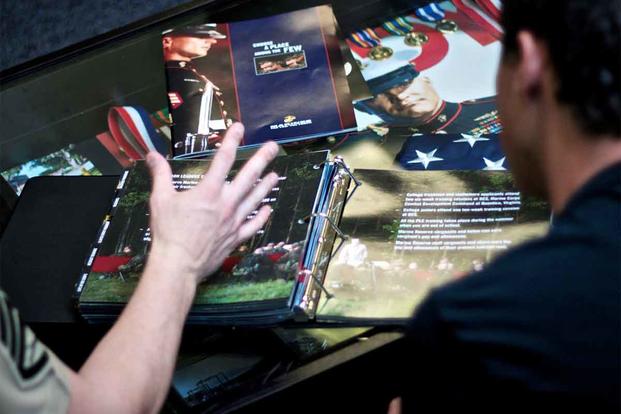Amid a military-wide recruiting crisis, the Marine Corps said Friday that it surpassed its recruiting goal for the fiscal year by just over two dozen people, according to data shared by the service with Military.com on Friday, a stark decrease from last year's numbers.
Officials said that the service sought to recruit 36,257 Marines this year, squeezing by with 36,286 total -- a difference of just 29 new Devil Dogs. That's a drop from the several hundred Marines recruited over the target number for fiscal 2023, even in the face of smaller recruiting goals this time around.
For new enlisted Marines, the margin of success was even smaller, with just one Marine pushing the service over its 30,500 enlisted recruit goal. For prior service reserve accessions -- both officer and enlisted Marines -- the Corps met its goal of 3,979 exactly.
Read Next: Stolen Valor & the 2024 Election
The service surpassed its overall goal by 351 people in 2023 and this year faced a goal that was 3,000 people lower overall -- still, it just squeaked by. The Corps has been one of the only branches -- outside of the small Space Force -- to reach its enlistment goals consistently in recent years as each of the services compete for a dwindling number of eligible applicants.
Recent Military.com reporting also showed that the Army and Air Force are fighting their own slumps, and fairing better after years of missing the mark -- sometimes missing them by wide margins in the Army's case. Recruiting success for those branches over the past year can be attributed to initiatives such as the Army's pre-basic training course program and changes to body fat standards and tattoo policies for the Air Force.
"This success is directly attributed to the hard work of our Marine recruiters and Officer Selection Officers working diligently in a competitive and challenging environment," Jim Edwards, a spokesperson for the Marine Corps Recruiting Command, said in an emailed statement Friday. "Marine recruiters accomplished the assigned recruiting mission, while maintaining the Marine Corps' high-quality standards."
Edwards also said that the service nearly tripled the number of Prior Service Enlistment Program applicants since last year, meaning that Marines who left the service applied back to the Corps in droves of over 200.
"The Marine Corps highly values these talented and experienced Marines and encourages their return to service," Edwards said. He also added that Marine Corps officers saw a boost from "diversity officer accessions" in that the program accounted for over one-third of all officer recruiting.
Military.com asked if the service had to dip into its Delayed Entry Program, or DEP, to achieve its numbers, a system that allows the Corps to forecast shipments of Marine hopefuls to recruit training and that has been used by services in previous years to stack recruit goals.
Edwards said that all Marines join the DEP prior to shipping to recruit training. The service did not have to lower its start pool to make its goals this past year, he said.
He also said that next year's DEP pool sits at around 27% and marks the first time since the COVID-19 pandemic started that the program has shown growth. That pool may be needed as the Corps faces an increased goal of 32,835 enlisted Marines next year, up from this year where it surpassed its enlisted goal by one.
Despite the diminished numbers, the service did indeed exceed its goals, and according to Katherine Kuzminski, a senior fellow at the Center for a New American Security think tank who specializes in military recruiting, the Marine Corps has the credibility to be picky with who it lets in.
"The Marine Corps benefits from tougher standards in that there might be individuals who are interested in joining the military, and they may want to join the Marine Corps, but they don't meet the Marine Corps standards," she said. "And the question of 'how much over they beat it by' is in some ways irrelevant, because they can be more selective in meeting that number."
That is coupled with a recently announced historic first-term reenlistment rate not seen in over a decade for the service; it reenlisted 114% of the first-term enlisted Marines it sought and reenlisted more than 5,700 subsequent-term Marines.
"So, I don't know that the Marine Corps competes with the other services in the way that they compete with each other," Kuzminski said. "We don't know how many people they turned away, who met the standard and who wanted to join because they were not as competitive as other candidates. Whereas the Army is not in a position to turn people away if they meet all the standards and they're willing to serve."
Edwards said that the recruiting arm of the service continues to focus on the needs of next year's mission.
"Marine recruiters seek to find and attract the Marine of tomorrow -- adaptable problem solvers who are resilient and interested in belonging," he said. "Our Marines maintain the high standards Americans expect of their Marine Corps, and they are more confident, focused and determined to overcome continued challenges and accomplish the mission in [fiscal 2025]."
Editor’s note: This story was updated with information from the Marine Corps about the delayed entry program.
Related: Army Surpasses its Goal for Recruiting Active-Duty Soldiers, But Just Barely














